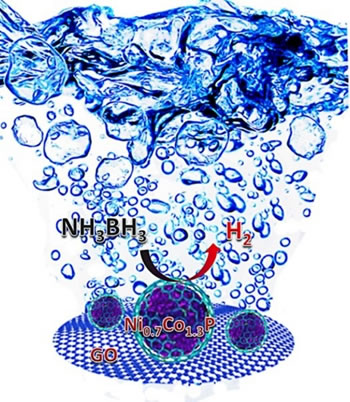Transition metal phosphides have semi-metallic characteristics, are stable in acid and alkali environments, and also have good light and thermal stability. They are a new type of catalytic material that occurs after transition metal carbides and transition metal nitrides. Electrocatalytic decomposition of hydrogen from aquatic products, catalytic hydrogenation, and dehydrogenation have shown catalytic activity comparable to that of precious metal platinum, which is known as a "quasi-platinum catalyst." The research group of photochemical conversion and synthesis research center of the Institute of Physics and Chemistry, Chinese Academy of Sciences has devoted many years to the preparation and photocatalytic properties of transition metal compounds. The researchers tried to use the transition metal phosphide as a cocatalyst to introduce a photocatalytic reaction system, and constructed a highly efficient cadmium sulfide/phosphide photocatalytically decomposed hydrogen system for hydrogen production. The hydrogen production rate was up to 200 mmol·h-1·g-1. On this basis, using the transition metal phosphide as a precursor, metal oxides/hydroxides generated by in-situ oxidation of the surface as a catalytic center enable efficient electrocatalytic decomposition of oxygen from water. So far, 8 papers on catalyzed water decomposition of phosphides have been published in the journals of Chem. Commun., ACS Appl. Mater. Interfaces, Appl. Catal. B: Environ., J. Mater. Chem. A. Studies have also shown that transition metal phosphides can also be used to catalyze the hydrolysis of ammonia borane, a chemical hydrogen storage material, to quickly release hydrogen from ammonia borane, and the rate of hydrogen evolution at room temperature reaches TOF=40.2 mol(H2) mol (Ni2P). ) -1 min-1. Recently, the researchers systematically controlled the electronic structure of the three-component metal phosphide Co-Ni-P by introducing different amounts of metallic cobalt, which promoted the charge transfer from the metal center to the phosphorus element and enhanced the interaction between the catalyst and the ammonia borane molecule. The nucleophilic attack on the ammonia borane molecule by the hydroxyl group in the water molecule greatly increases the rate of hydrogen hydrogen release from ammonia borane. The researchers collaborated with Nuria López, a professor at the Catalan Institute of Chemistry in Spain, to theoretically study the catalytic reaction mechanism in detail. The relevant research results were published in the Energy and Environmental Science (2017, 10, 1770–1776). This work was supported by the National Key Basic Research Program of the Ministry of Science and Technology (973 Program), the Strategic Pilot Science and Technology Project of the Chinese Academy of Sciences (Class B) and the 100-person Project (Class A) and the National Natural Science Foundation of China.
Huijie Steel Pipe provide variety of Profile Steel Tubes for automotive parts,,engineering machinery,agricultural
machinery,furniture,construction materials,Supplied as DIN,ASTM,ASME,EN,BS,JIS,GOST,GB etc standard
including the Seamless special pipes/SMLS profile steel pipes/ERW profile steel pipes,
We can offer the profile Steel Tubes:
Seamless/ERW Rectangle Steel Tubes,
Seamless/ERW Omega Steel Pipes,
Seamless/ERW Hexagonal Steel Tube
Outside Hexagonal and Inside Round Steel Tube,
Outside Round and Inside Hexagonal Steel Tube,
Seamless/ERW elliptical steel tube,
Seamless/ERW Oval Steel Tube,
The special profile steel tubing can be produced by customer drawing.
Hexagonal Tubes,Hexagon Steel Pipes,Outer Hexagon Tubing,Hexagon Seamless Tubes Ningbo Huijie Steel Pipe Manufacturing Co.,Ltd , https://www.hjbearingtube.com
Ammonia borane water liberating hydrogen reaction activity is improved by adjusting the electronic structure of metal phosphide
Seamless/ERW Rectangle Steel Pipes,
Seamless/ERW Square Steel Tubes,
Seamless/ERW Square Steel Pipes,
Seamless/ERW Omega Steel Tube,